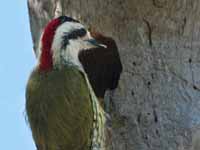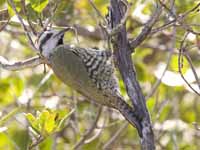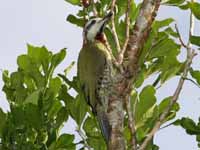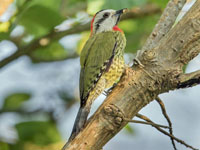The order Piciformes is made up of the woodpecker family Picidae plus 8 other families. Picidae make up about half of the species. In general, the Piciformes are insectivorous, but some exceptions eat mostly fruit. Nearly all Piciformes have parrot-like feet—two toes forward and two back, an arrangement that has obvious advantages for birds that spend much of their time on tree trunks. And most Piciformes do not have down feathers at any age, only true feathers. All nest in cavites.
Family Picidae: Woodpeckers and Allies
The woodpeckers family members are found almost worldwide. Most species live in forests or woodland habitats, although a few species are known to live in treeless areas such as rocky hillsides and deserts. They range in size from 8-50 cm. Many species exhibit patches of red and yellow on their heads and bellies, and these bright areas are important in signalling. Although the sexes of Picidae species tend to look alike, many have more prominent red or yellow head markings in males than in females.
Members of the family Picidae have strong bills for drilling and drumming on trees and long sticky tongues for extracting food. Species that use their bills in soil or for probing as opposed to regular hammering tend to have longer and more decurved bills. To prevent brain damage from the rapid and repeated decelerations, woodpeckers have evolved a number of adaptations to protect the brain. These include small brain size and the short duration of contact. The millisecond before contact with wood a thickened membrane closes, protecting the eye from flying debris. The nostrils are also protected, they are often slit-like and have special feathers to cover them. In addition to the strong claws and feet woodpeckers have short strong legs, this is typical of birds that regularly forage on trunks. The tails of most woodpeckers are stiffened, and when the bird perches on vertical surfaces, the tail and feet work together to support it. Picidae species can either be sedentary or migratory.
There are 7 articles pertaining to the woodpecker family Picidae: African, Eurasian, North America, South America, Small, Large, Terrestrial.
The article describes six woodpecker genera: Dryobates, Leuconotopicus, Melanerpes, Picoides, Sphyrapicus, and Xiphidiopicus. They are mainly found in North America and Central America which eographically is really part ot North America, its tail end. Since South America is connected to North America, it is not surprising that these genera contain a considerable number of its South American species also.
Of the 5 Dryobates species listed here, 3 are found in North America and the others in Europe and Asia. On the otherhand, Clements Checklist of THE WORLD BIRDS places 31 species in this genus. In particular, it places in Dryobates all the species that others have in Leuconotopicus and Veniliornis. The Dryobates woodpeckers that are treated here are relative small with a length of 14 to 19 cm. The North American species (downy, ladder-backed, and Nuttall's woodpeckers) all have black and white plumage, except for some red on the head. They forage on trees and eat mainly insects.
There are six Leuconotopicus woodpeckers. All except the smoky-brown woodpecker which is found in South America, are restricted to North America. They are medium sized woodpeckers with a length between 18 to 24 cm. They mainly eat insects, but also fruit and seeds. Their nest is usually excavated in a dead tree or a dead branch of a living tree.
Most of the North American woodpeckers are members of Melanerpes. Twelve of the Melanerpes species are just found in North America, three species in North and South America, and five are found just in South America. More so than most woodpeckers, the Melanerpes woodpeckers have a varied diet. Most prefer insects, but also eat other arthropods, fruit, and seeds. Some cache nuts for future consumption. And a fair number of these species will catch insects on the fly. Their name means "black creeper". These woodpeckers all have some black on their upperparts and all have black bills. They range from the white-fronted woodpecker with a length of 16 to 18 cm to the West Indian woodpecker with a length of 28 to 30 cm. In all cases, the sexes are of similar appearance. Usually there are coloration difference on the head, with the male being brighter. The Guadeloupe, Lewis's, and the red-headed woodpeckers cannot be sex differentiated based on appearance. Most of these species excavate their nest cavities in dead trees or dead limbs of living trees. Live trees are also used by some species. When available, cactus are also excavated for nest cavities - they are relatively soft for easy excavation and cactus thorns can afford protection from snakes. A couple of species also use palm trees for the cavity site.
Birds in the Picoides genus are mainly black and white. All three species have three toes, instead of the normal four that almost all other woodpeckers have. Two of the species live in northern North America, and the Eurasian three-toed woodpecker lives in northern Eurasia. They mainly eat beetle larvae, but also other insects, fruit, and some sap. Unlike most other woodpeckers, these species do not usually peck perpendicular to the tree to forage for insects. Instead they peck more laterally to dislodge the bark, not to make a hole in the tree. Whether this foraging method is a result of having only three toes is unknown.
The Sapsuckers of genus Sphyrapicus are restricted to North America. The are medium sized woodpeckers with a length of 17 to33 cm. They feed mainly on the sap of trees which they tap by making small holes. A sapsucker's tongue is adapted with stiff hairs for collecting the sap. They visit the same tree multiple times drilling holes to cause the sap to flow. This may eventually kill the tree. The insects attracted to the sap are also consumed, and not only by sapsuckers. They excavate their nests in trees. There is also one species in Xiphidiopicus, the Cuban green woodpecker.
Of all the species described here only one does not have a conservation status of Least Concern. The red-cockaded woodpecker is listed as Near Threatened because it has breeding requirements that rely on large pine trees. Most of the other woodpeckers are more tolerant in their habitat requirements and can usually adapt to highly degraded woodlands.
Genus Dryobates Found : mainly North America
Woodpecker,_Crimson-breasted Dryobates cathpharius
Description: The crimson-breasted woodpecker has mainly black upperparts with some white on the wings. It has a white forehead and black fore-crown. The rear-crown and nape are red for the male and black for the female. The face and chin are white with a black malar stripe. It has mainly whitish underparts with thin dark stripes. Some have a little red on the breast. The crimson-breasted woodpecker is 17 to 19 cm long.
Range: Bangladesh, Bhutan, China, India, Laos, Myanmar, Nepal, Thailand, and Vietnam.
Habitat: Forests.
Diet: Insects, nectar. Forages on lower parts of trees and bushes.
Conservation status: Least Concern.
Image by: 1) Ron Knight 2) Francesco_Veronesi - IndiaRange: Bangladesh, Bhutan, China, India, Laos, Myanmar, Nepal, Thailand, and Vietnam.
Habitat: Forests.
Diet: Insects, nectar. Forages on lower parts of trees and bushes.
Conservation status: Least Concern.
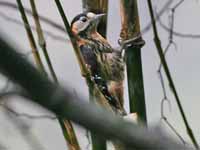
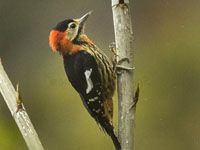
Woodpecker,_Downy Dryobates pubescens Found: Canada, United States
Description: The downy woodpecker has mainly black upperparts with white in the center of the back and white spotting on the wings. The underparts are white. It has a wide black eye-line which is bordered above and below with white. The male has a red spot on back of the head. The downy woodpecker is 14 to 17 cm long which makes it the smallest North American woodpecker. The similar hairy woodpecker is considerably larger than downy woodpecker and the hairy's bill is proportionately larger.
Range: Most of North America but not the far north and the southwest deserts.
Habitat: They prefer open deciduous woodlands.
Diet: Mainly insects. Also seeds and berries, suet from bird feeders.
Conservation status: Least Concern.
Image by: 1) Dick Daniels - North Carolina 4) Dick - Maryland 2, 3) Alan
D Wilson - Northern
Vancouver Island, British ColumbiaRange: Most of North America but not the far north and the southwest deserts.
Habitat: They prefer open deciduous woodlands.
Diet: Mainly insects. Also seeds and berries, suet from bird feeders.
Conservation status: Least Concern.
1, 2) Female 3, 4) Male
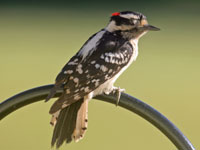
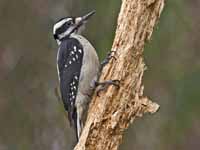
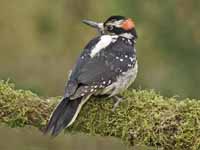
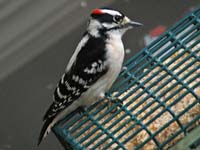
Woodpecker,_Ladder-backed Dryobates scalaris
Description: The ladder-backed woodpecker has a black and white barred back. The spacing of the bars is wide, resembling a ladder. It has cream colored underparts with spotted flanks and breast. The male has a mainly red crown with some brown on the forecrown and also some white spots there. The female has a black forehead and brown crown.
There is a thin black eye-line which is bordered above and below by white. It has a black malar stripe. The ladder-backed woodpecker is 16 to 18 cm long. The similar Nuttall's woodpecker has more black on the cheek.
Range: Southwest United states to Nicaragua.
Habitat: Deserts, desert scrub, and thorn forests. Also open pine and pine–oak woodland.
Diet: Insects. It forages on trees and also cacti.
Conservation status: Least Concern.
Image by: 1, 3) Jeff Whitlock - Texas 2) Mrccos - Texas 4) Alan D Wilson - Phoenix Range: Southwest United states to Nicaragua.
Habitat: Deserts, desert scrub, and thorn forests. Also open pine and pine–oak woodland.
Diet: Insects. It forages on trees and also cacti.
Conservation status: Least Concern.
1, 2) Female 3, 4) Male


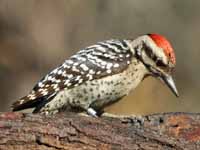
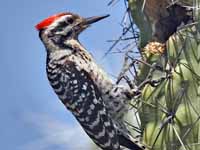
Woodpecker,_Lesser Spotted Dryobates minor
Description: The lesser spotted woodpecker has a black nape and upper back. The rest of the upperparts are black with white bars where the spacing between bars increasing down the back. It has white underparts with streaked flanks. The male has a crimson fore-crown while for the female it is white. The rear-crown plus nape are black and the face is white. The lesser spotted woodpecker is the smallest European woodpecker with a length of 14 to 16 cm and a weight of 15 to 25 grams.
Range: Europe, Asia.
Habitat: Forest edges, woodlands, park, gardens.
Diet: Insects. Wood boring larvae in winter, other times insects on the surface of trees.
Conservation status: Least Concern.
Image by: 1) Vitalii_Khustochka - Ukraine 2) Zaltys - Finland 3) Thermos - Finland 4) Maris_Pukitis - LatviaRange: Europe, Asia.
Habitat: Forest edges, woodlands, park, gardens.
Diet: Insects. Wood boring larvae in winter, other times insects on the surface of trees.
Conservation status: Least Concern.
1) Male 2 - 4) Female
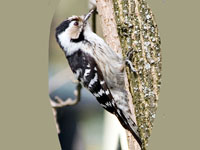
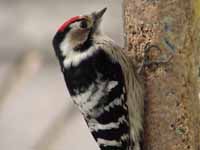
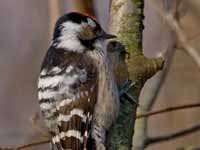
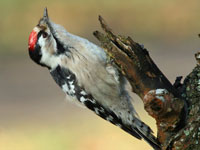
Woodpecker,_Nuttall's Dryobates nuttallii
Description: The Nuttall's woodpecker has black and white barred upperparts. It has a black forehead and face with a broad white supercilium and a narrow white malar stripe. It has a white throat and upper breast with the rest of the underparts having faint spots and bars. The male has a black fore-crown and red rear-crown while the female has a crown that is entirely black. The lower-rear of the eye has a white eye-arc. The Nuttall's woodpecker is 16 to 18 cm long. It has more black on the cheek than the similar Ladder-backed woodpecker.
Range: Western North America.
Habitat: Chaparral and oak woodlands.
Diet: Mainly larvae of ants and beetles that if forages by pecking. Also seeds and berries.
Conservation status: Least Concern.
Image by: 1, 2) Mike Baird 3) Steve Corey - California 4) ADJ82 - CaliforniaRange: Western North America.
Habitat: Chaparral and oak woodlands.
Diet: Mainly larvae of ants and beetles that if forages by pecking. Also seeds and berries.
Conservation status: Least Concern.
1. 2) Female 3) Male
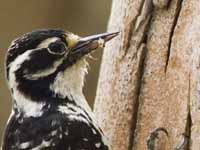

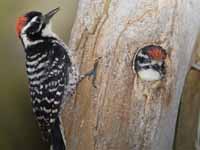
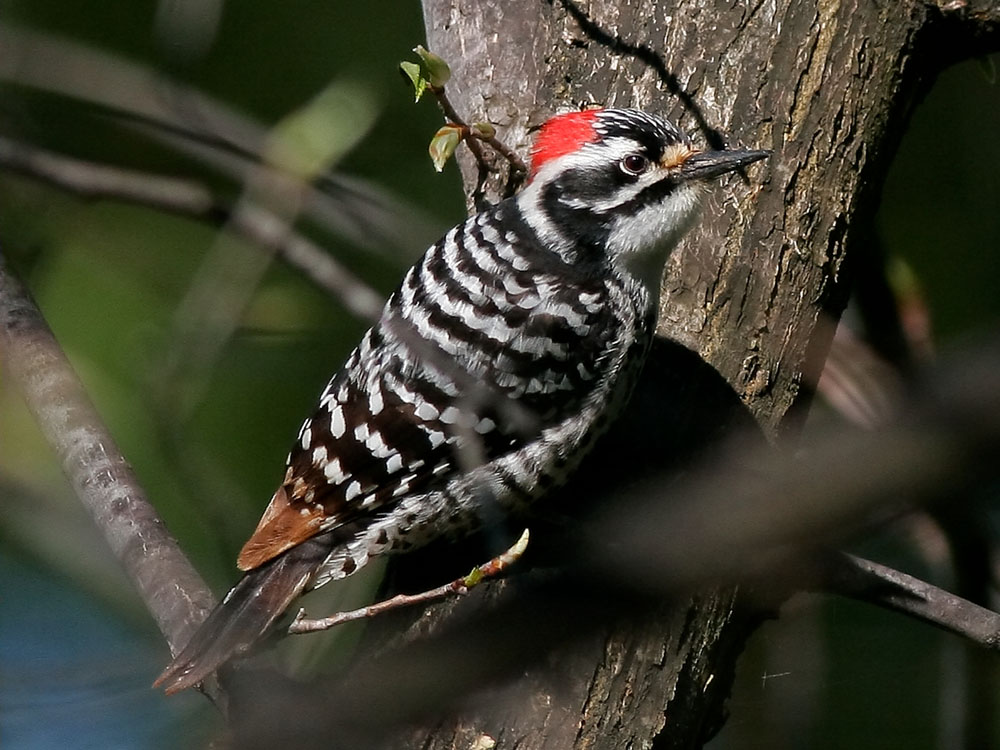
Genus Leuconotopicus Found : mainly North America
Clements Checklist of THE WORLD BIRDS places all species from Leuconotopicus in Dryobates.
Except for the smoky-brown woodpecker which is found in South America, these six speciesare restricted to North America. They are medium sized woodpeckers with a length between 18 to 24 cm. They mainly eat insects, but also fruit and seeds. Their nest is usually excavated in a dead tree or a dead branch of a living tree.
Except for the smoky-brown woodpecker which is found in South America, these six speciesare restricted to North America. They are medium sized woodpeckers with a length between 18 to 24 cm. They mainly eat insects, but also fruit and seeds. Their nest is usually excavated in a dead tree or a dead branch of a living tree.
Woodpecker,_Arizona Leuconotopicus arizonae
Description: The Arizona woodpecker has brown upperparts and white underparts with black spots. It has a red crown, mainly white nape with some red, and a dark eye patch on a mainly white face. The female is duller than the male. The Arizona woodpecker is 18 to 24 cm long.
Range: Northwestern Mexico and southwestern United States.
Habitat: Oak and woodlands which natuarally tend to be rather open.
Diet: Insects, larvae. Also fruits and acorns.
Conservation status: Least Concern.
Image by: 1, 2) Alan D. Wilson 3) New
Jersy Birds Range: Northwestern Mexico and southwestern United States.
Habitat: Oak and woodlands which natuarally tend to be rather open.
Diet: Insects, larvae. Also fruits and acorns.
Conservation status: Least Concern.
1) Female 2, 3) Male
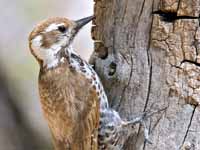
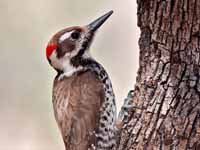
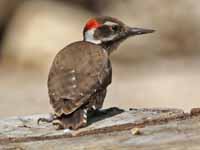
Woodpecker,_Hairy Leuconotopicus villosus
Description: The hairy woodpecker has mainly black upperparts with white in the center of the back, white underparts, white spotting on the wings, a white streak above and below the eye, and a black eye-line. The male has a red spot on the back of the head. The hairy woodpecker is about 25 cm long. The similar downy woodpecker has a shorter bill than the hairy woodpecker which is considerably larger than the downy.
Range: Southern Canada, most of the United States, and Central America.
Habitat: Mature deciduous woodlands.
Diet: Mainly insects, but also fruit, berries, and nuts. They forage on trees.
Conservation status: Least Concern.
Image by: 1) Alan D. Wilson - Oregon 2, 3) Dick Daniels - Palmer, Alaska 4) Ted Grussing - ArizonaRange: Southern Canada, most of the United States, and Central America.
Habitat: Mature deciduous woodlands.
Diet: Mainly insects, but also fruit, berries, and nuts. They forage on trees.
Conservation status: Least Concern.
1) Female 2, 3, 4) Male (red on back of head)
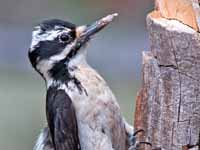

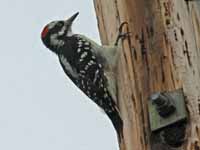
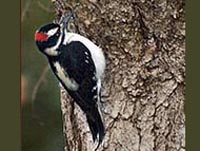
Woodpecker,_Red-cockaded Leuconotopicus borealis
Description: The red-cockaded woodpecker has black upperparts with dotted white barring. The underparts are whitish at the breast, then blending to greyish at the belly. The underparts also have black dots which becoming barring toward the flanks. The red-cockaded woodpecker's most distinguishing feature is a black cap, nape, and malar stripe that encircle large white cheek patches. The male has a difficult to see small red streak on each side of its black cap called a cockade.The red-cockaded woodpecker is 20 to 23 cm long which makes it larger than the downy by smaller than the hair woodpeckers.
Range: Southeast United States.
Habitat: They require large living pine trees where they excavate their nest cavities. Above and below the nest cavity they make smaller holes so that resin will make it difficult for snakes to reach the nest.
Diet: Insects and other anthropods. Also fruit and seeds.
Conservation status: They are listed as Near Threatened because of diminishing number of suitable nest trees.
Image by: 1) Matthew K Hacker 2) Julio Mulero - Florida 3) Jerry Oldenettel - Mississippi Range: Southeast United States.
Habitat: They require large living pine trees where they excavate their nest cavities. Above and below the nest cavity they make smaller holes so that resin will make it difficult for snakes to reach the nest.
Diet: Insects and other anthropods. Also fruit and seeds.
Conservation status: They are listed as Near Threatened because of diminishing number of suitable nest trees.
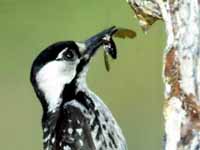
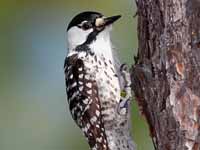
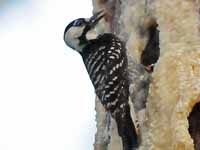
Woodpecker,_Smoky-brown Leuconotopicus fumigatus
Description: The smoky-brown woodpecker has dark brown upperparts and buff underparts. It has a mainly greenish-brown head with lighter ear-coverts. The male has a red crown. The smoky-brown woodpecker is about 18 cm long.
Range: Central America, South America.
Habitat: Subtropical or tropical moist forests. Also heavily degraded forests.
Diet: Insects, especially small beetles and their larvae.
Conservation status: Least Concern.
Image by: 1) Francesco_Veronesi - Ecuador 2) Michael Woodruff - Ecuador 3) Nick_Athanas - EcuadorRange: Central America, South America.
Habitat: Subtropical or tropical moist forests. Also heavily degraded forests.
Diet: Insects, especially small beetles and their larvae.
Conservation status: Least Concern.
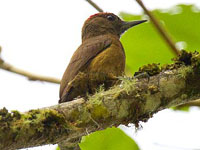
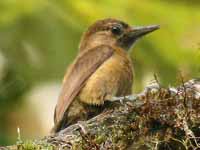
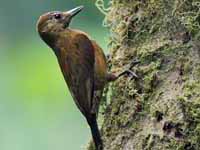
Woodpecker,_Strickland's Leuconotopicus stricklandi
Description: The Strickland's woodpecker has brown upperparts with white barring along the center of the back. The dark brown head has a white patch above the eye, another beyond the ear-coverts, and a white malar stripe. The male has a red patch on the nape. The underparts are white, speckled with many brown spots. The Strickland's woodpecker is 18 to 19 cm long. The similar Arizona woodpecker, of which it used to be considered a subspecies, does not have white barring on its back.
Range: Eastern Mexico.
Habitat: Montane pine forests and mixed pine-oak.
Diet: Mainly beetle larvae, other insects, seeds, fruit.
Conservation status: Least Concern.
Image by: 1) Jorge Montejo - Mexico 2) Amy McAndrews - MexicoRange: Eastern Mexico.
Habitat: Montane pine forests and mixed pine-oak.
Diet: Mainly beetle larvae, other insects, seeds, fruit.
Conservation status: Least Concern.
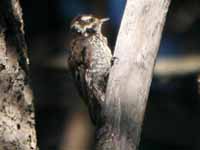

Woodpecker,_White-headed Leuconotopicus albolarvatus
Description: The white-headed woodpecker has black upperparts, a white head, and white primary feathers. The male has a red spot at the back of his head. The underparts are also black. The white-headed woodpecker is about 20 cm long. It is similar to the acorn woodpecker, but has much more white on its head,
Range: Western mountains of North America.
Habitat: Forests with a predominance of pines.
Diet: Pine seeds, ants, beetles, their larvae, and other insects.
Conservation status: Least Concern.
Image by: 1, 3) Dave McMullen - California 2) Marcel Holyoak - California 4) Alan D. Wilson - OregonRange: Western mountains of North America.
Habitat: Forests with a predominance of pines.
Diet: Pine seeds, ants, beetles, their larvae, and other insects.
Conservation status: Least Concern.
1) Female 2, 3, 4) Male
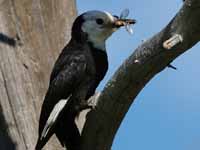
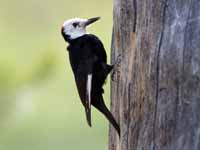
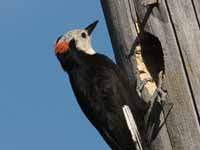
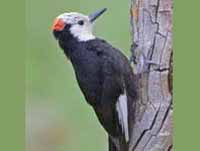
Genus Melanerpes Found : New World
These species are found in the New World. Twelve species are found just in North America, three species in North and South America, and six are found just in South America.
More so than most woodpeckers, the Melanerpes woodpeckers have a varied diet. Most prefer insects, but also eat other arthropods, fruit, and seeds. Some cache nuts for future consumption and a fair number of these species will catch insects on the fly.
Their name means "black creeper". These woodpeckers all have some black on their upperparts and all have black bills. They range from the white-fronted woodpecker with a length of 16 to 18 cm, to the West Indian woodpecker with a length of 28 to 30 cm. In all cases, the sexes are of similar appearance. Usually there are coloration difference on the head, with the male being brighter. The Guadeloupe , Lewis's, and the red-headed woodpeckers cannot be sex differentiated based on appearance.
Most of these species excavate their nest cavities in dead trees or dead limbs of living trees. Live trees are also used by some species. When available, cactus are also excavated for nest cavities - they are relatively soft for easy excavation and cactus thorns can afford protection from snakes. A couple of species also use palm trees for the cavity site.
More so than most woodpeckers, the Melanerpes woodpeckers have a varied diet. Most prefer insects, but also eat other arthropods, fruit, and seeds. Some cache nuts for future consumption and a fair number of these species will catch insects on the fly.
Their name means "black creeper". These woodpeckers all have some black on their upperparts and all have black bills. They range from the white-fronted woodpecker with a length of 16 to 18 cm, to the West Indian woodpecker with a length of 28 to 30 cm. In all cases, the sexes are of similar appearance. Usually there are coloration difference on the head, with the male being brighter. The Guadeloupe , Lewis's, and the red-headed woodpeckers cannot be sex differentiated based on appearance.
Most of these species excavate their nest cavities in dead trees or dead limbs of living trees. Live trees are also used by some species. When available, cactus are also excavated for nest cavities - they are relatively soft for easy excavation and cactus thorns can afford protection from snakes. A couple of species also use palm trees for the cavity site.
Woodpecker,_Acorn Melanerpes formicivorus
Description: The acorn woodpecker has black upperparts including the wings and tail. It has a white forehead and red rear-crowned. The male has a black fore-crown while for the female it is black. There is a black patch around the bill and around the eyes which are white. It has a black bill and black legs, The underparts are white with black streaks on the breast. The acorn woodpecker is 19 to 23 cm long. The similar white-headed woodpecker has more white on its head.
Range: Southwest North America and Columbia of South America.
Habitat: Wooded areas with oaks.
Diet: Acorns, insects, fruit. They store acorns in tree holes that are carefully chosen to be able to hold a single acorn.
Conservation status: Least Concern.
,Range: Southwest North America and Columbia of South America.
Habitat: Wooded areas with oaks.
Diet: Acorns, insects, fruit. They store acorns in tree holes that are carefully chosen to be able to hold a single acorn.
Conservation status: Least Concern.
Image by: 1) Katy & Sam - Arizona 2) Kevin Cole- CA 3) Andrej_Chudy - California 4) Steve Ryan
1, 2) Female 3, 4) Male
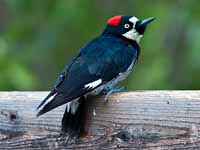
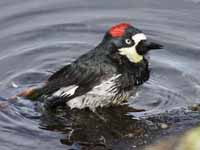
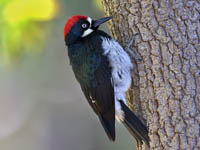
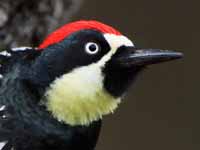
Woodpecker,_Beautiful Melanerpes pulcher
Description: The beautiful woodpecker has a yellow nape, a black back with white center streak, black mask continuing along the neck, and barred flanks. The male has a red crown and yellow nape while the female has a black fore-crown, red rear-crown, and yellow crown. It has a black bill and grey legs. The beautiful woodpecker is about 18 cm long. The ranges of the similar golden-naped woodpecker and beautiful woodpecker do not overlap.
Range: Columbia.
Habitat: Forests, forest edges, and secondary growth.
Diet: Mainly figs, bananas, fruits, and palm nuts. Also insects. It forages mostly in trees, but can take insects on the fly.
Conservation status: Least Concern.
Image by: 1) Alejandro_Bayer_Tamayo 2) Felix_Uribe 3) Dave_Curtis Range: Columbia.
Habitat: Forests, forest edges, and secondary growth.
Diet: Mainly figs, bananas, fruits, and palm nuts. Also insects. It forages mostly in trees, but can take insects on the fly.
Conservation status: Least Concern.
1, 2) Female 3) Male
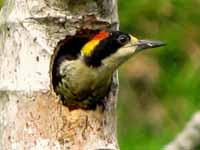
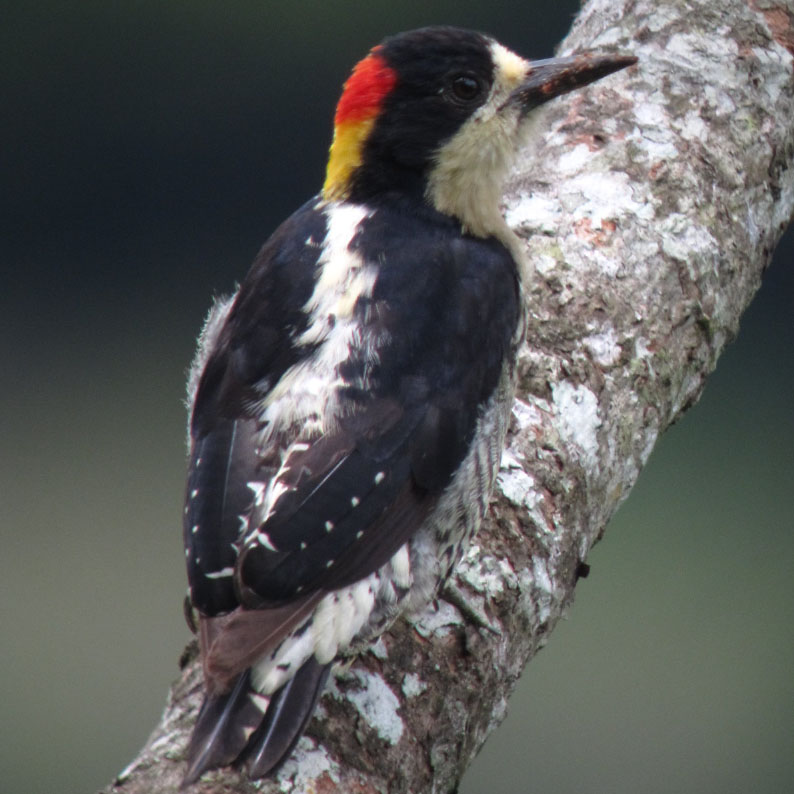
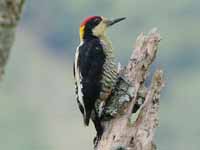
Woodpecker,_Black-cheeked Melanerpes pucherani
Description: The black-cheeked woodpecker has black upperparts with white barring, white spots on the wings and a white rump, and a black tail with some white barring. It has pale buff-olive underparts with a red central patch. There is a black patch around the eyes and on the cheeks. The forehead is yellowish white and the nape is red. It has a black bill and grey legs. The male has a red crown while the female has a mainly white crown. The black-cheeked woodpecker is about 18 cm long.
The similar golden-naped woodpecker has a golden nape while the black-cheeked woodpecker has a red nape.
Range: Mexico, Central America, northern South America.
Habitat: Higher levels of wet forests, semi-open woodland and old second growth.
Diet: Insects, but also fruit and nectar.
Conservation status: Least Concern.
Image by: 1, 2) Jerry Oldenettel - Costa
Rica 3) David Cook - Ecuador 4) Don_Faulkner - Costa RicaRange: Mexico, Central America, northern South America.
Habitat: Higher levels of wet forests, semi-open woodland and old second growth.
Diet: Insects, but also fruit and nectar.
Conservation status: Least Concern.
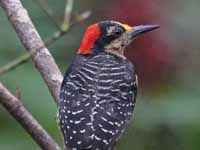

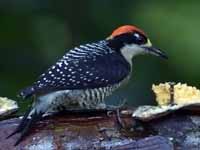
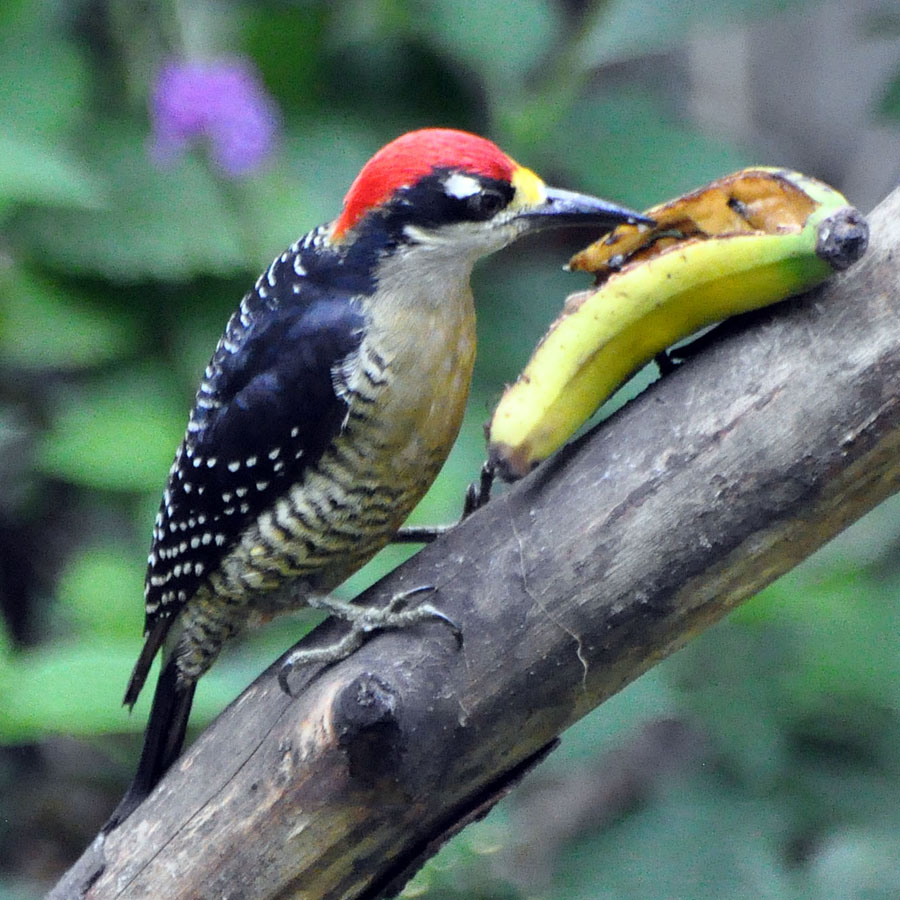
Woodpecker,_Gila Melanerpes uropygialis Found: desert regions of
Description: The gila woodpecker has black upperparts including the tail with white barring, It has a greyish-tan neck, throat, head, and underparts. The male has a small red cap head, while the female does not. It excavates nest holes in the saguaro cactus. The gila woodpecker is 22 to 24 cm long.
Range: Southwest United States, Mexico.
Habitat: Low desert scrub.
Diet: Mainly insects. Also fruit, seeds, nectar. Forages in trees by gleaning and pecking.
Conservation status: Least Concern.
Image by: 1) Charlie Westerinen - Arizona 2) Dick Daniels - Arizona 3) Dick Daniels - North Carolina Zoo 4) Chris Queen Range: Southwest United States, Mexico.
Habitat: Low desert scrub.
Diet: Mainly insects. Also fruit, seeds, nectar. Forages in trees by gleaning and pecking.
Conservation status: Least Concern.
1, 2) Female 3, 4) Male
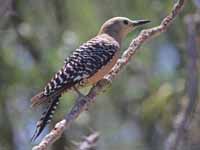
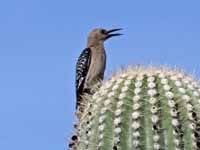
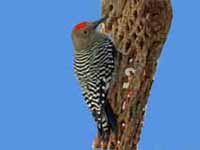

Woodpecker,_Golden-cheeked Melanerpes chrysogenys
Description: The golden-cheeked woodpecker has black and white barred upperparts including the tail. It has pale grey underparts with a yellow-tinged belly. The forehead and nape are yellow, there is a yellowish wash on cheeks, and also a small black eye patch. The male has a red crown patch while for the female the patch is grey.
The "black eye" of the Golden-cheeked woodpecker is unique. The golden-cheeked woodpecker is 19 to 22 cm long. It excavates its nest in a tree or cactus.
Range: Mexico.
Habitat: Subtropical or tropical forests, heavily degraded former forest.
Diet: Mainly beetles, ants, fruits and seeds. Also other insects.
Conservation status: Least Concern.
Image by: 1) Len Blumin - San Blas, Nayarit, Mexico 2) Alexander_Carrillo 3) Bryant_Olsen 4) Dominic_Sherony Range: Mexico.
Habitat: Subtropical or tropical forests, heavily degraded former forest.
Diet: Mainly beetles, ants, fruits and seeds. Also other insects.
Conservation status: Least Concern.
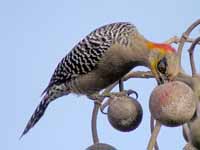
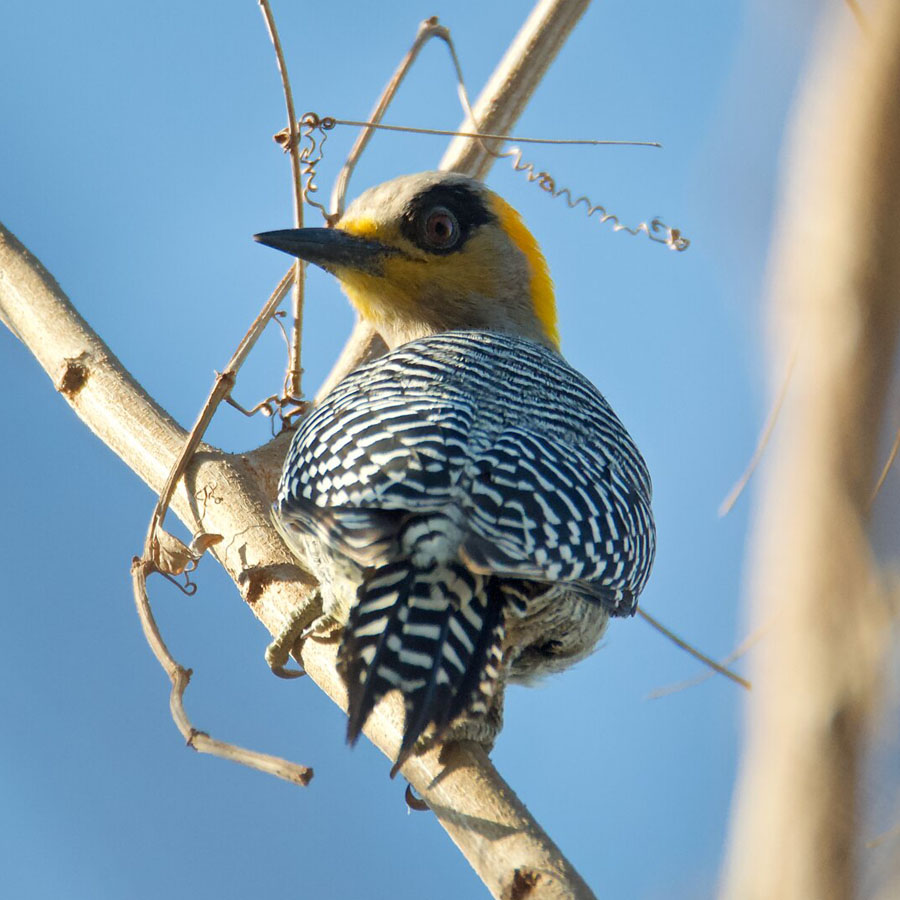
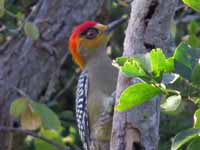
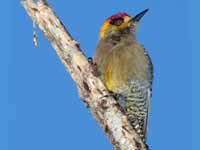
Woodpecker,_Golden-fronted Melanerpes aurifrons
Description: The golden-fronted woodpecker has black and white barred upperparts and a white rump. It has a golden forehead. The male has a red crown and nape while the female has a grey crown and golden nape. The underparts are grey, the bill black, and the feet are grey. The golden-fronted woodpecker is 22 to 26 cm long.
Range: United States (Oklahoma, Texas), Mexico, Central America.
Habitat: Woodlands, second growth forests, and scrubland.
Diet: Grasshoppers, beetles, ants, corn, acorns, fruit. It forages in trees and on the ground.
Conservation status: Least Concern.
Image: 1) Brian Ralphs - Texas 2) Jerry Oldenettel 3) Becky_Matsubara - Mexico 4) Alan D. Wilson Range: United States (Oklahoma, Texas), Mexico, Central America.
Habitat: Woodlands, second growth forests, and scrubland.
Diet: Grasshoppers, beetles, ants, corn, acorns, fruit. It forages in trees and on the ground.
Conservation status: Least Concern.
1) Female 2 - 4) Male

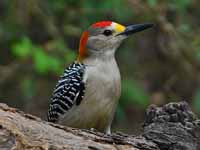

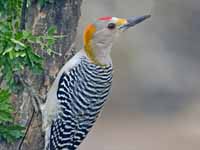
Woodpecker,_Golden-naped Melanerpes chrysauchen
Description: The golden-naped woodpecker has a yellow nape and black upperparts with a white center streak. It has black mask which continues along the neck. The breast is yellow and the belly is grey with black barring. It has a black bill and grey legs. The male has a red crown with yellow forehead while the female has yellow crown with a black band. The golden-naped woodpecker is 18 cm long. It is similar to the beautiful woodpecker but their ranges do not overlap.
Range: Costa Rica, Panama.
Habitat: Rainforests, more open woodlands, degraded forests near more pristine woods, plantations.
Diet: Mainly fruit; also insects. It will forage on trees and hawk for insects on the wing,.
Conservation status: Least Concern.
Image by: 1) Charles Sharp - Costa Rica 2) Doug Greenberg - Costa Rica Range: Costa Rica, Panama.
Habitat: Rainforests, more open woodlands, degraded forests near more pristine woods, plantations.
Diet: Mainly fruit; also insects. It will forage on trees and hawk for insects on the wing,.
Conservation status: Least Concern.

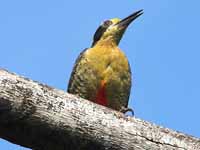
Woodpecker,_grey-breasted Melanerpes hypopolius
Description: The grey-breasted woodpecker has black upperparts with white barring. The head, neck, and most of the underparts are light greyish-brown. The lower belly has some black barring. Only the male has a small red cap. It has a black bill. The grey-breasted woodpecker is 19 to 21 cm long. The nest cavity is excavated in a tree or cactus.
Range: Southwestern Mexico.
Habitat: Relatively open and dry areas that have cactus present.
Diet: Fruits and insects. It forages on trees, cacti, and also on the ground. The grey-breasted woodpecker stores food.
Conservation status: Least Concern.
Image by: 1, 2) Amy McAndrews 3) Nigel VoadenRange: Southwestern Mexico.
Habitat: Relatively open and dry areas that have cactus present.
Diet: Fruits and insects. It forages on trees, cacti, and also on the ground. The grey-breasted woodpecker stores food.
Conservation status: Least Concern.
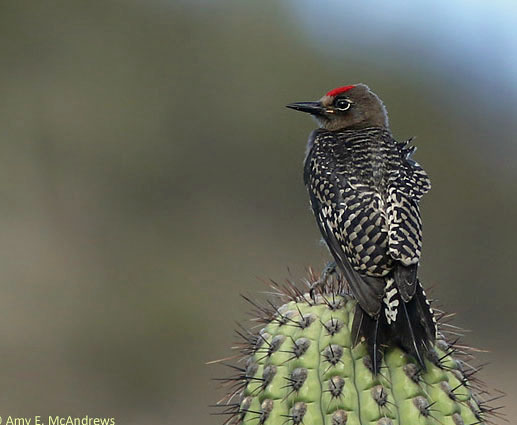
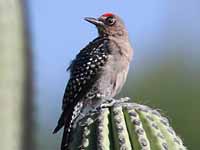
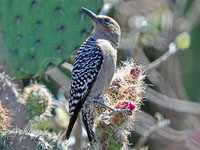
Woodpecker,_Guadeloupe Melanerpes herminieri
Description: The Guadeloupe woodpecker has black plumage with the upperparts having a bluish gloss. It has a black bill and dark legs. The Guadeloupe woodpecker is 24 to 26 cm long. It usually excavates its nest in a dead coconut palm, but will use a live palm or also a tree for the nest site.The male and female are identical in appearance, except males are slightly larger.
Range: Guadeloupe in the Caribbean.
Habitat: Moist lowland forests, mangroves, swamps.
Diet: Ants, termites and other insects, fruit.
Conservation status: Least Concern.
Image by: 1. 2) Anthony_Levesque Range: Guadeloupe in the Caribbean.
Habitat: Moist lowland forests, mangroves, swamps.
Diet: Ants, termites and other insects, fruit.
Conservation status: Least Concern.
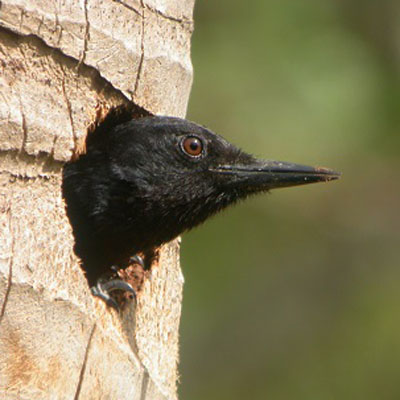
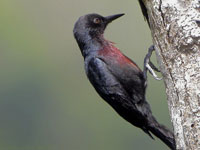
Woodpecker,_Hispaniolan Melanerpes striatus
Description: The Hispaniolan woodpecker has black upperparts with yellow-green bars, a black tail, red nape, and a red (male) or black (female) crown. It has a pale grey face and chin. The underparts are olive. It has yellow eyes, a dark grey bill, and grey legs. The Hispaniolan woodpecker is 23 to 25 cm long.
Range: Hispaniola in the Caribbean.
Habitat: Mainly woodlands. Also plantations, cactus scrub, mangrove areas, swamps, grasslands,
Diet: Insects, fruit, seeds. It forages mainly in trees by gleaning and pecking. Also hawks insects in flight.
Conservation status: Least Concern.
Image by: 1, 3) Mark Peck 2) Martingloor 4) Wolfgang Wander - Dominican RepublicRange: Hispaniola in the Caribbean.
Habitat: Mainly woodlands. Also plantations, cactus scrub, mangrove areas, swamps, grasslands,
Diet: Insects, fruit, seeds. It forages mainly in trees by gleaning and pecking. Also hawks insects in flight.
Conservation status: Least Concern.
1, 2) Female 3) Male
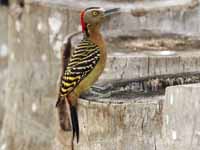
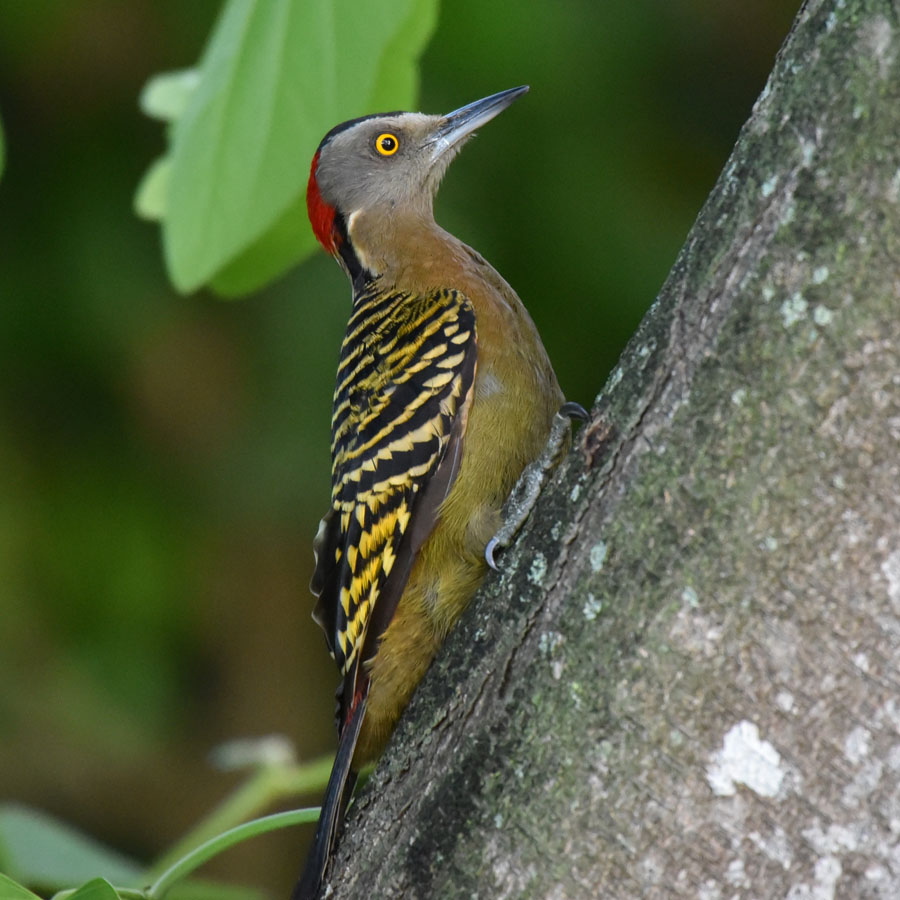
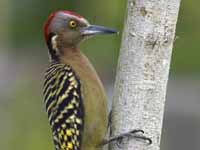
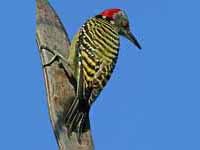
Woodpecker,_Hoffman's Melanerpes hoffmannii :
Description: The Hoffman's woodpecker has black and white barred upperparts and a white rump. It has pale buff-grey underparts with a yellow central belly patch that is usually hidden, a white forehead, and a yellow nape. The male has a red crown while the female's is white. It has a black bill. The Hoffman's woodpecker is about 25 cm long.
Range: Southern Honduras south to Costa Rica.
Habitat: Deciduous open woodland, second growth, shade trees and hedges, but avoids dense forest.
Diet: Insects; also fruit and nectar.
Conservation status: Least Concern.
Image by: 1) Joao Quental - Costa Rica 2) Dominic_Sherony 3) Jerry Oldenettel - Costa Rica 4) Johnathan_Nightingale - Costa RicaRange: Southern Honduras south to Costa Rica.
Habitat: Deciduous open woodland, second growth, shade trees and hedges, but avoids dense forest.
Diet: Insects; also fruit and nectar.
Conservation status: Least Concern.
1, 2) Female 3 ,4) Male
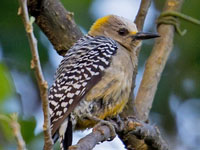
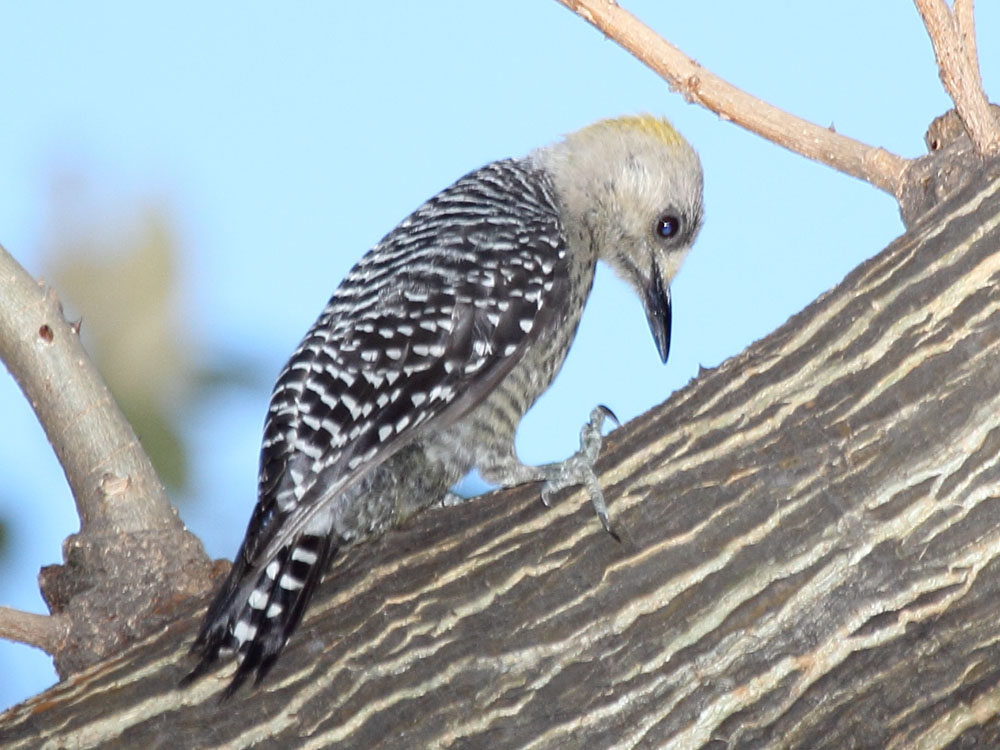
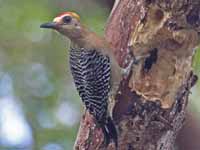
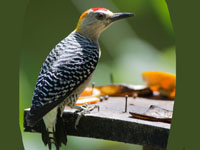
Woodpecker,_Jamaican Melanerpes radiolatus
Description: The Jamaican woodpecker has black upperparts with thin white barring. The tail is also black, but with no barring. It has a white forehead and face. The male has a red crown and nape while the female has a grey crown and red nape. The underparts are yellowish-brown with an orange patch on the belly. It has a red bill and grey legs. The Jamaican woodpecker is 25 to 27 cm long.
Range: Jamaica.
Habitat: Moist lowland forests and heavily degraded former forest.
Diet: Insects and fruit about equally.
Conservation status: Least Concern.
Image by: 1) Dick Daniels - Rockland Feeding Station, Jamaica 2) Ron Knight 3) Charles_J_SharpRange: Jamaica.
Habitat: Moist lowland forests and heavily degraded former forest.
Diet: Insects and fruit about equally.
Conservation status: Least Concern.
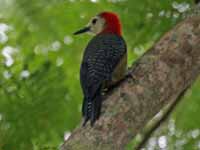
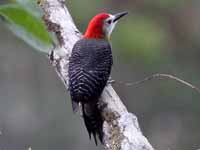
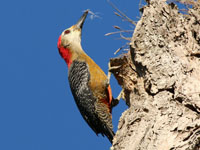
Woodpecker,_Lewis's Melanerpes lewis
Description: The Lewis's woodpecker has bronze-green upperparts. It has a dark head and red face with a silver collar. It has pinkish underparts with faint streaking. The male and female cannot be separated by color. The Lewis's woodpecker is 25 to 28 cm long. It has broad wings which leads to its flight being slow and even, more like a crow than a typical woodpecker flight.
Range: Western North America.
Habitat: Pine woodlands, and other areas with scattered trees and snags.
Diet: Insects, berries, nuts. Pecks in trees for insects, hawks them in the air, and stores nuts for the future.
Conservation status: Least Concern.
Image by: 1) Len Blumin 2, 3) Alan D Wilson - Near Fort Rock, Oregon 4) Linda Tanner - CARange: Western North America.
Habitat: Pine woodlands, and other areas with scattered trees and snags.
Diet: Insects, berries, nuts. Pecks in trees for insects, hawks them in the air, and stores nuts for the future.
Conservation status: Least Concern.
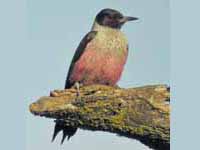
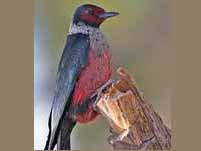
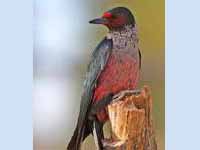

Woodpecker,_Puerto Rican Melanerpes portoricensis
Description: The Puerto Rican woodpecker has dark blue upperparts including the crown, nape, wings, and tail. It has a white forehead and thaat white extends to eye-rings. It has pale brown underparts with orange-red along the middle. The male's throat and breast are brighter than the female's. The Puerto Rican woodpecker is about 23 cm long.
Range: Puerto Rico.
Habitat: Woodlands, plantations, parks.
Diet: Insects, worms, fruits.
Conservation status: Least Concern.
Image by: 1) Drriss_n_Marrionn 2) Michael_J_AndersenRange: Puerto Rico.
Habitat: Woodlands, plantations, parks.
Diet: Insects, worms, fruits.
Conservation status: Least Concern.
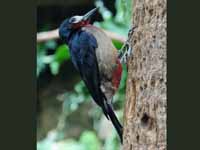
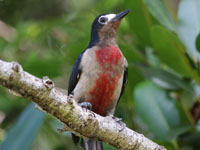
Woodpecker,_Red-bellied Melanerpes carolinus
Description: The red-bellied woodpecker has black and white barred upperparts. There is light grey on the face and underparts. It has a red nape and red forehead. The belly may have a red tinge. The male also has a red crown. The red-bellied woodpecker is 23 to 26 cm long. The nest cavity is usually constructed in a dead tree or in a dead branch.
Range: Eastern North America.
Habitat: Deciduous forests, pine forest, mangroves.
Diet: Insects and other arthropods, nuts, fruit. Forages on trees by gleaning and pecking, occasionally on the ground.
Conservation status: Least Concern.
Image by: 1, 2, 3, 4) Dick Daniels - North Carolina Range: Eastern North America.
Habitat: Deciduous forests, pine forest, mangroves.
Diet: Insects and other arthropods, nuts, fruit. Forages on trees by gleaning and pecking, occasionally on the ground.
Conservation status: Least Concern.
1, 2) Female 3. 4) Male 2) Note the RED on the belly.
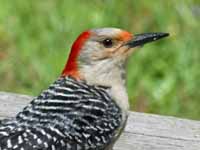
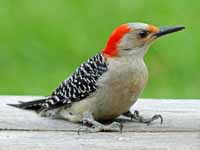


Woodpecker,_Red-crowned Melanerpes rubricapillus Found: Cental and South America
Description: The red-crowned woodpecker has black and white barred upperparts, a white rump, pale buff underparts, and a red nape. The male has a red crown and nape while the female has buff crown and a duller nape. The red-crowned woodpecker is 17 cm long.
Range: Costa Rica, Panama, Colombia, Venezuela, the Guianas and Tobago.
Habitat: Forests and semi-open woodland and cultivation.
Diet: Insects; also fruit and nectar from feeders.
Conservation status: Least Concern.
Image by: 1) Arley_Vargas 2) Julian_Londono - Columbia 3) Alejandro_Bayer_Tamayo 4) Jan_Willem_SteffelaarRange: Costa Rica, Panama, Colombia, Venezuela, the Guianas and Tobago.
Habitat: Forests and semi-open woodland and cultivation.
Diet: Insects; also fruit and nectar from feeders.
Conservation status: Least Concern.
1, 2) Female 3, 4) Male
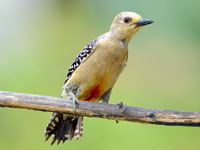

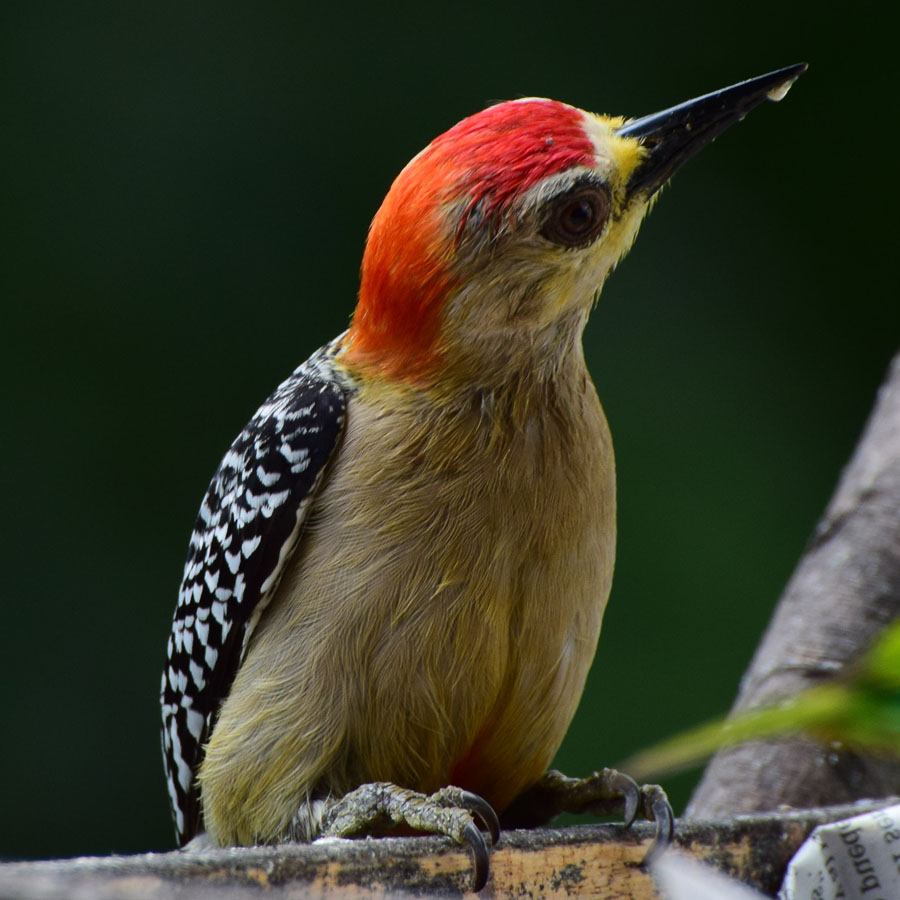
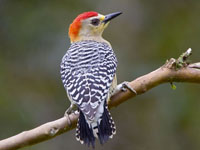
Woodpecker,_Red-headed Melanerpes erythrocephalus
Description: The red-headed woodpecker has black upper back, a white band across the lower back, and a black tail. The head and neck are red. It has white underparts. Adult males and females are identical in plumage. The red-headed woodpecker is 20 to 24 cm.
Range: Southern Canada to Gulf of Mexico and Florida. Not west of the Rocky Moutains.
Habitat: Open woodlands, parks, treed savannas
Diet: Insects, seeds, fruits, berries, nuts, and occasionally small rodents. Forages on trees, or gathers and stores nuts, catches insects in the air. Probably the best flycatcher of all the woodpeckers.
Conservation status: Least Concern.
Image by: 1) Laura Gooch - Ohio 2) Christian_Fritschi - Quebec 3, 4) Dick Daniels - North Carolina Range: Southern Canada to Gulf of Mexico and Florida. Not west of the Rocky Moutains.
Habitat: Open woodlands, parks, treed savannas
Diet: Insects, seeds, fruits, berries, nuts, and occasionally small rodents. Forages on trees, or gathers and stores nuts, catches insects in the air. Probably the best flycatcher of all the woodpeckers.
Conservation status: Least Concern.
1) Juvenile
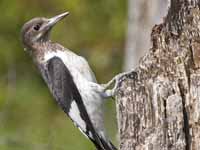
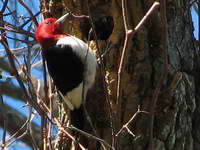
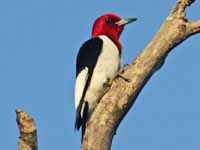
Woodpecker,_West_Indian Melanerpes superciliaris
Description: The West Indian woodpecker has black and white barred upperparts. It has a
pale buff breast, and reddish belly. Most subspecies have a short black streak angling back from the eye. The male has a red crown in front of that black streak while the female has a while crown. They both have a red nape. The male has a red crown. The face and throat are white. The West Indian woodpecker is 28 to 30 cm long.
Range: Bahamas, Cayman Islands and Cuba.
Habitat: Tropical forests, heavily degraded forests, mangroves.
Diet: Insects, fruit, seeds. Also some vertebrates.
Conservation status: Least Concern.
Image by: 1) Charles_J_Sharp 2, 3)
Blake Maybank - Cuba 4) Dominic Sherony Range: Bahamas, Cayman Islands and Cuba.
Habitat: Tropical forests, heavily degraded forests, mangroves.
Diet: Insects, fruit, seeds. Also some vertebrates.
Conservation status: Least Concern.
1, 2) Female 3, 4) Male

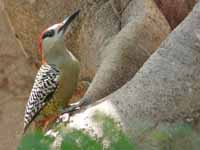
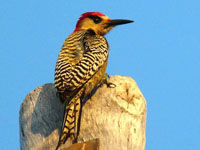
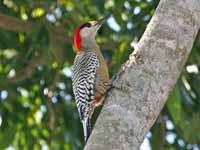
Woodpecker,_White Melanerpes candidus
Description: The white woodpecker has black upperparts and tail. The head is white with a black line from behind they eye extending to the back. There is a yellow eye patch. The underparts are white with sometimes a yellow patch visible on the belly, The under-tail coverts are black. The male has some yellow on the nape, the female only has white on the nape. The white woodpecker is 25 to 29 cm long. In addition to trees, it has been known to excavate its nest cavity in palms and also perhaps use holes in rocks.
Range: South America (east of the Andes).
Habitat: Forest edges, open woodland, plantations, treed savannah.
Diet: Mainly fruit; also seeds, insects.
Conservation status: Least Concern.
Image by: 1, 2) Cláudio Timm -Brazil 3, 4) Dario Sanches - BrazilRange: South America (east of the Andes).
Habitat: Forest edges, open woodland, plantations, treed savannah.
Diet: Mainly fruit; also seeds, insects.
Conservation status: Least Concern.
1, 2 Female 3, 4) Male
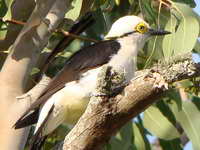
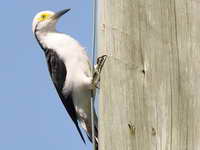

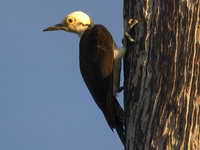
Woodpecker,_White-fronted Melanerpes cactorum
Description: The white-fronted woodpecker has a black upper-back with an off-white stripe in its middle. The lower-back and tail are black with white spots. It has off-white underparts and there is indistinct barring on the flanks and lower belly. It has a white forehead. The throat is pure white or may have some yellow depending on the subspecies. The hind-crown is black and the eyes are in that black area. The male has a small patch of red on the crown, but it is not always visible. The white-fronted woodpecker is 16 to 18 cm long.
Range: Mainly in Bolivia, Paraguay and Argentina; also southeastern Peru and Brazil.
Habitat: Savannah and semi-desert with scattered trees, shrubs and cacti. It also occurs in palm groves, forest edges, and agricultural land with scattered trees.
Diet: Insects and fruit.
Conservation status: Least Concern.
Image by: 1, 2) Lip Kee - Argentina 3) Nick_Athanas -BrazilRange: Mainly in Bolivia, Paraguay and Argentina; also southeastern Peru and Brazil.
Habitat: Savannah and semi-desert with scattered trees, shrubs and cacti. It also occurs in palm groves, forest edges, and agricultural land with scattered trees.
Diet: Insects and fruit.
Conservation status: Least Concern.
3) Female
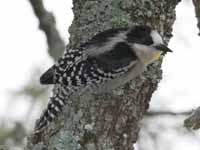
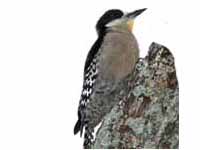

Woodpecker,_Yellow-fronted Melanerpes flavifrons Found: South America
Description: The yellow-fronted woodpecker has black upperparts including the tail. The male has a
yellow forehead, red crown and nape, and a black mask. The female has a
yellow forehead, and a black crown, nape, and mask. They have a greenish grey breast, red belly, plus black and white barred flanks. The yellow-fronted woodpecker is 18 cm long. It is a cooperative breeder, with extra males and or females sometimes helping out.
Range: Brazil, Paraguay and far northeastern Argentina.
Habitat: Sparsely forested areas, secondary forests, palm groves, orchards, gardens and parkland,
Diet: Mainly fruits and berries. Also insects.
Conservation status: Least Concern.
Image by: 1, 2) Nick_Athanas - Argeniana, Brazil 3) Dario Sanches - Brazil 4) ThunderdcRange: Brazil, Paraguay and far northeastern Argentina.
Habitat: Sparsely forested areas, secondary forests, palm groves, orchards, gardens and parkland,
Diet: Mainly fruits and berries. Also insects.
Conservation status: Least Concern.
1) Female 2, 3, 4) Male
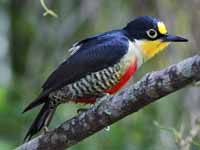
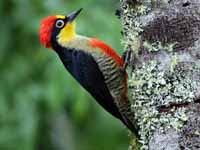

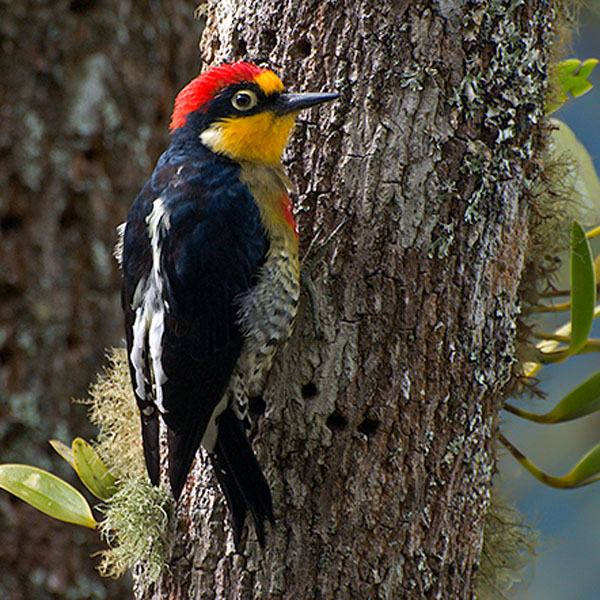
Woodpecker,_Yellow-tufted Melanerpes cruentatus
Description: The Yellow-tufted woodpecker has bluish-black upperparts, cheeks, chin, throat, and upper-breast. It has a bold yellow eye-ring and arc that leads to the back of its head. The eyes are also yellow. The male has a small red crown area, while for the female it is black. There is a variable sized red patch on the lower-breast that may extend to the belly. The lower belly and flanks have black and white barring. It is a cooperative breeder. The Yellow-tufted woodpecker is 19 cm long.
Range: North-central South America.
Habitat: Woodlands, degraded forest, even burned out areas with isolated standing trees.
Diet: Mainly insects; also fruit. Forages in trees and also can catch insects on the wing.
Conservation status: Least Concern.
Image by: 1) Marco_Parra 2, 4) Nick_Athanas - Columbia 3) Francesco Veronesi - EcuadorRange: North-central South America.
Habitat: Woodlands, degraded forest, even burned out areas with isolated standing trees.
Diet: Mainly insects; also fruit. Forages in trees and also can catch insects on the wing.
Conservation status: Least Concern.
1, 2) Female 4) Male

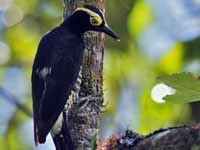
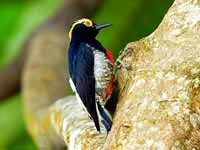
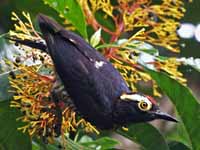
Woodpecker,_Yucatan Melanerpes pygmaeus
Description: The Yucatan woodpecker has black and white barred upperparts. The face and underparts are mostly grey. The male has a red rear-cap and nape plus yellow around the base of the bill. The female has some red on the nape and less yellow around the bill. The Yucatan woodpecker is 17 cm long. The similar golden-fronted woodpecker has red around the base of the bill instead of yellow.
Range: The Yucatán Peninsula and adjoining offshore islands. Mexico, Belize, Guatemala, Hondoras.
Habitat: Dry forests, degraded forests, and dry scrublands.
Diet: Probably insects and also some fruit.
Conservation status: Least Concern.
Image by: 1) Drriss_n_Marrionn 2) Amy McAndrews 3) Dominic_SheronyRange: The Yucatán Peninsula and adjoining offshore islands. Mexico, Belize, Guatemala, Hondoras.
Habitat: Dry forests, degraded forests, and dry scrublands.
Diet: Probably insects and also some fruit.
Conservation status: Least Concern.
1) Female 2, 3) Male

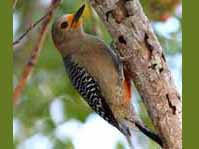

Genus Picoides Found : mainly North America
Birds in this genus are mainly black and white. All three species have three toes, instead of the normal four that almost all other woodpeckers have. Two of the species live in northern North America, and the Eurasian three-toed woodpecker lives in northern Eurasia. They mainly eat beetle larvae, but also other insects, fruit, and some sap.
Woodpecker,_American Three-toed Picoides dorsalis
Description: The American three-toed woodpecker has 3 toes versus the normal 4 for most woodpeckers. It has a black back with white barring. THe wings and rump are similarly patterned. There is white along the center-line of the back. The flanks are barred black and white with emphasis on the white. The rest of the underparts are white as is the throat. There is a white eye-ring which continues as a white line to the back. The male has a yellow cap. The American three-toed woodpecker has a length of 21 cm. It is similar to the black-backed woodpecker which is also three-toed. The Black-backed woodpecker does not have any white on its back. The American three-toed woodpecker and Eurasian three-towed woodpecker were once consider one species. Their ranges do not over lap.
Range: Canada, western USA.
Habitat: Coniferous forests.
Diet: Mainly beetle larvae. Also other insects, fruit, sap.
Conservation status: Least Concern.
Image by: 1) Pbonefant 2) Bettina_Arrigoni 3, 4) Charlie Westerinen - Utah Range: Canada, western USA.
Habitat: Coniferous forests.
Diet: Mainly beetle larvae. Also other insects, fruit, sap.
Conservation status: Least Concern.
1) Pair 2, 3) Female 4 - 7) Male

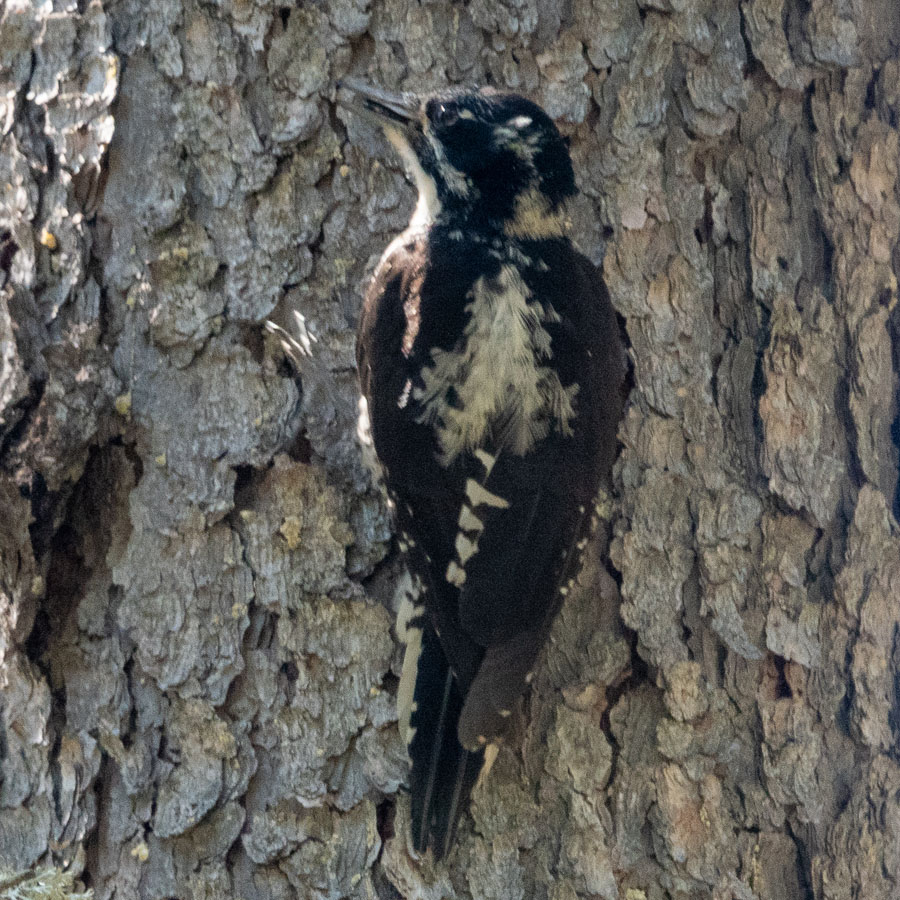
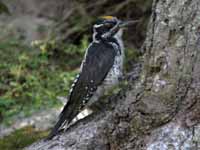
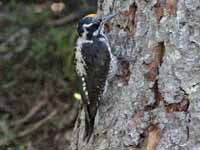
Woodpecker,_Black-backed Picoides arcticus
Description: The black-backed woodpecker has 3 toes versus the normal 4 for most woodpeckers. It has black upperparts, a black face with white stripe, white underparts, black and white barred flanks with emphasis on the white. The male has a yellow cap. The black-backed woodpecker is about 23 cm long. The similar American three-toed woodpecker is also three-toed. It has some white on its back, the Black-backed woodpecker does not.
Range: Mainly Canada. Also northern United States.
Habitat: Boreal forests.
Diet: Mainly beetle larvae. It forages mainly by gleaning.
Conservation status: Least Concern.
Image by: 1) Don Brubacher - New Brunswick 2) USFWS - Vermont 3) S Fitzgerald - Michigan Range: Mainly Canada. Also northern United States.
Habitat: Boreal forests.
Diet: Mainly beetle larvae. It forages mainly by gleaning.
Conservation status: Least Concern.
1) Female 2, 3) Male
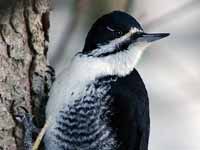
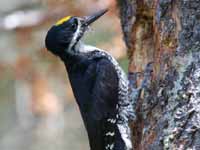
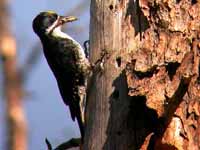
Woodpecker,_Eurasian_Three-toed Picoides tridactylus Found: Europe, Asia
Description: The Eurasian three-toed woodpecker has 3 toes versus the normal 4 for most woodpeckers. It has black on the head, wings, and ump. It has white underparts, black and white barred flanks with emphasis on the white, and white in the center of the back. The male has a yellow cap. The Eurasian three-toed woodpecker is about 22 cm long. The American Three-toed woodpecker and Eurasian Three-towed woodpecker were once consider one species. Their ranges do not over lap.
Range: Northern Europe across northern Asia to Japan.
Habitat: Coniferous forests.
Diet: Mainly beetle larvae. Also other insects, fruit, sap.
Conservation status: Least Concern.
Range: Northern Europe across northern Asia to Japan.
Habitat: Coniferous forests.
Diet: Mainly beetle larvae. Also other insects, fruit, sap.
Conservation status: Least Concern.
Image by: 1) Tatiana Bulyonkova - Novosibirskaya Oblast, Russia 2) SergeyYeliseev - Moscow, Russian 3) Francesco_Veronesi - Finland
1) Female 2, 3) Male
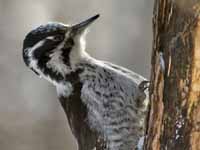
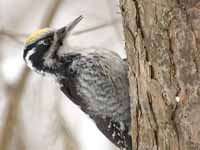

Genus Sphyrapicus Found : North America
The sapsuckers are found in North America. They feed mainly on the sap of trees which they tap by making small holes. A sapsucker's tongue is adapted with stiff hairs for collecting the sap. They visit the same tree multiple times drilling holes to cause the sap to flow. This may eventually kill the tree. The insects attracted to the sap are also consumed, and not only by sapsuckers. They excavate their nests in trees.
Sapsucker, Red-breasted Sphyrapicus ruber
Description: The red-breasted sapsucker has a red upper-breast, throat, and head. The back is black with a white center-line, black wings, and a large white wing patch. There is white near the base of the bill plus a white lower-breast, lower belly and rump. Sexes have the same plumage. The red-breasted sapsucker is 20 to 22 cm long. The similar red-naped sapsucker does not have a red and throat.
Range: West coast of North America.
Habitat: Pine, hemlock, Douglas-fir, fir, and spruce forests. They prefer old growth forests.
Diet: Sap, insects, and fruit.
Conservation status: Least Concern.
Image by: 1) Mack Ewalt - Oregon 2) USFWS - Washington 3) Len Blumin - California 4) Veit - CaliforniaRange: West coast of North America.
Habitat: Pine, hemlock, Douglas-fir, fir, and spruce forests. They prefer old growth forests.
Diet: Sap, insects, and fruit.
Conservation status: Least Concern.
1) Juvenile
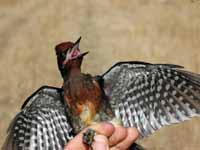
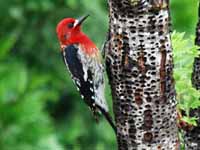
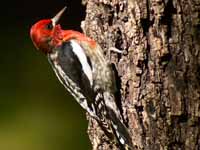

Sapsucker, Red-naped Sphyrapicus nuchalis
Description: The red-naped sapsucker has mainly black upperparts with some white along the center.It has black wings with a large white wing patch. It has a red fore-crown, black rear-crown, and a red nape. The male has a completely red throat while female has white at top of throat andred at lower part. The red-naped sapsucker is 19 to 21 cm long. The red-naped sapsucker does not have a red upper-breast as does the similar red-breasted sapsucker.
Range: Western North America (small range in Canada, large in Mexico).
Habitat: Mixed forests.
Diet: Insects, especially those attracted to their sap. Other insects and fruit,
Conservation status: Least Concern.
Image by: 1) Jerry Oldenettel - New Mexicoa 2) Matt MacGillivray - Alberta, Canada 3) Wildbill_Co - Colorado 4) Alan D. Wilson -
British ColumbiaRange: Western North America (small range in Canada, large in Mexico).
Habitat: Mixed forests.
Diet: Insects, especially those attracted to their sap. Other insects and fruit,
Conservation status: Least Concern.
1, 2) Female 3, 4) Male
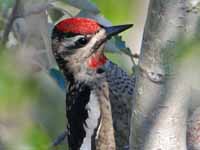

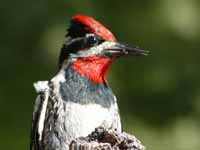
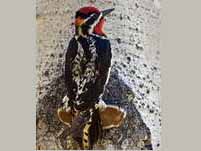
Sapsucker,_Williamson's Sphyrapicus thyroideus
Description: The male Williamson's sapsucker has a black back, head, throat and upper breast. The belly is bright yellow. It has a large white wing patch, a white stripe behind eye and a lower white stripe on the face. The female has a black back with fine white bars, a brown head, and a yellowish breast. The Williamson's sapsucker is about 23 cm long.
Range: Western North America.
Habitat: Conifer forest and also those forests mixed with hardwoods.
Diet: Mainly insects during the breeding season; also sap and berries.
Conservation status: Least Concern.
Image by: 1) ) Eleanor Briccetti - California 2) Charlie Westerinen - CA 3) Francesco_Veronesi - Oregon 4) Bryant_OlsenRange: Western North America.
Habitat: Conifer forest and also those forests mixed with hardwoods.
Diet: Mainly insects during the breeding season; also sap and berries.
Conservation status: Least Concern.
1, 2) Female 3, 4) Male
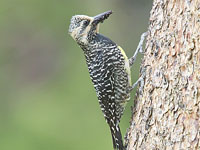
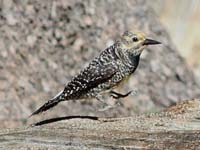
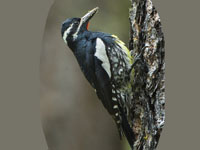
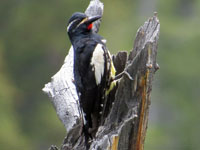
Sapsucker, Yellow-bellied Sphyrapicus varius
Description: The yellow-bellied sapsucker has a black back. It has black wings with white bars and a white wing patch. The black head has white lines on the sides, a red forehead and a red crown. The breast and upper belly are yellowish while the lower-belly and rump are white. The male has a red throat while the female has a white throat. The yellow-bellied sapsucker is 18 to 21 cm long.
Range: Much of Canada, east United States, Mexico, Central America, Caribbean.
Habitat: Forest edges, open woodlands, pastures with large trees.
Diet: Insects and other arthropods, tree sap, fruits, and nuts.
Conservation status: Least Concern.
Image by: 1) Keith Williams - Yukon Territory, Canada 2) Charles_Sharp - Cuva 3)Tony Harvey - Kentucky 4) Dick Daniels - Ash, North CarolinaRange: Much of Canada, east United States, Mexico, Central America, Caribbean.
Habitat: Forest edges, open woodlands, pastures with large trees.
Diet: Insects and other arthropods, tree sap, fruits, and nuts.
Conservation status: Least Concern.
1, 2) Female 3, 4) Male
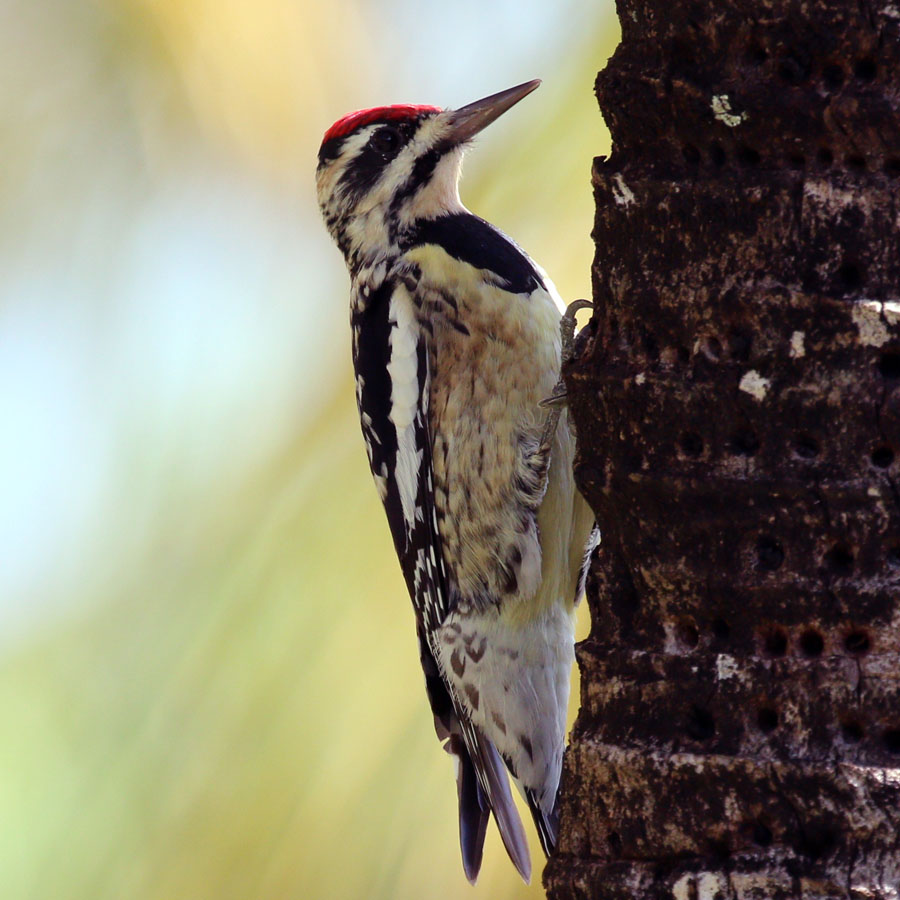
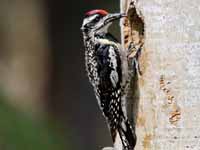
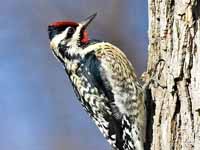
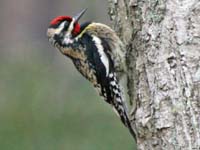
Genus Xiphidiopicus - 1 species
Woodpecker,_Cuban_Green Xiphidiopicus percussus
Description: The Cuban green woodpecker has green upperparts. It has a red nape stripe bordered by white. Its white face has a black eye-line, white face with black eye-line. There is also a black chin and throat. The male has red crown, female has black crown with white stripes. It has yellow underparts with the breast having dark streaks and the flanks black bars. The Cuban green woodpecker is 21 to 25 cm with the female considerably smaller than the male.
Range: Cuba.
Habitat: Forests and also heavily degraded former forests.
Diet: Insects, fruit.
Conservation status: Least Concern.
Image by: 1) Tony Tea 2) Laura Gooch 3) Dominic
Sherony 4) Peter_HartRange: Cuba.
Habitat: Forests and also heavily degraded former forests.
Diet: Insects, fruit.
Conservation status: Least Concern.
